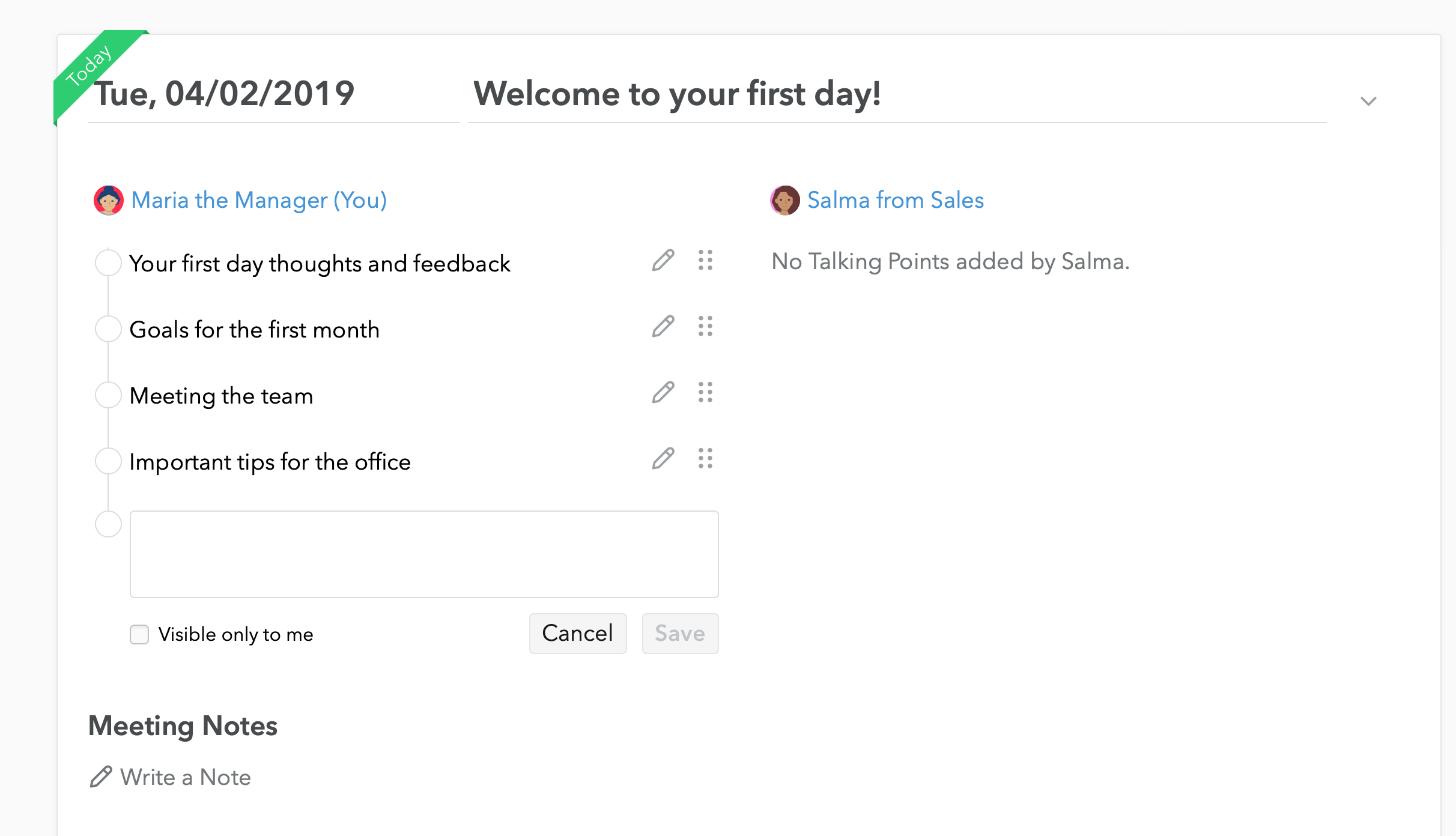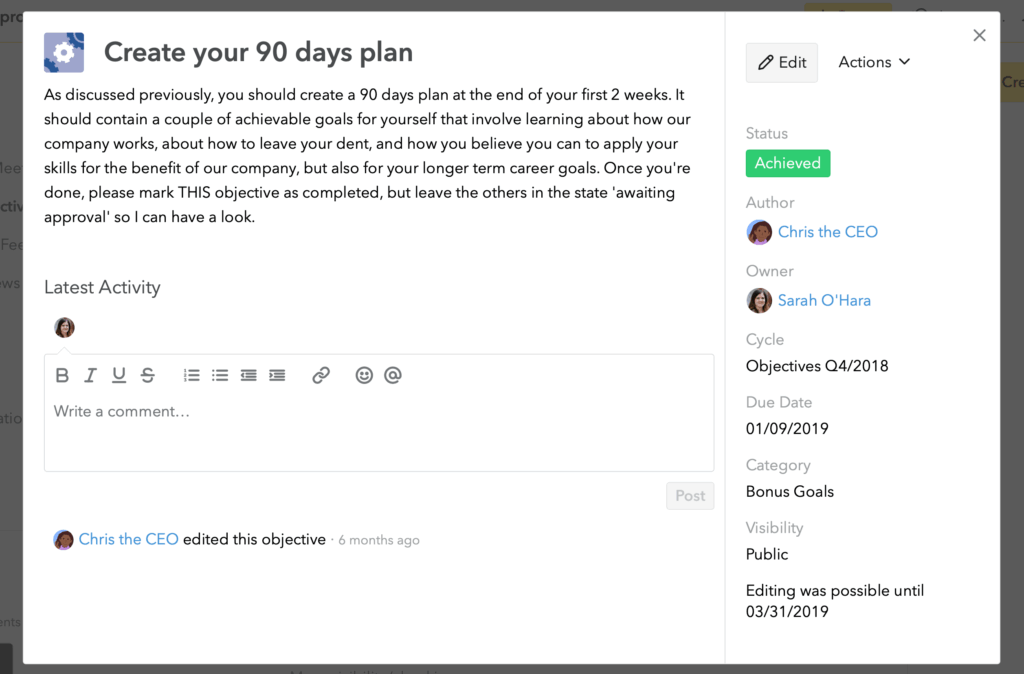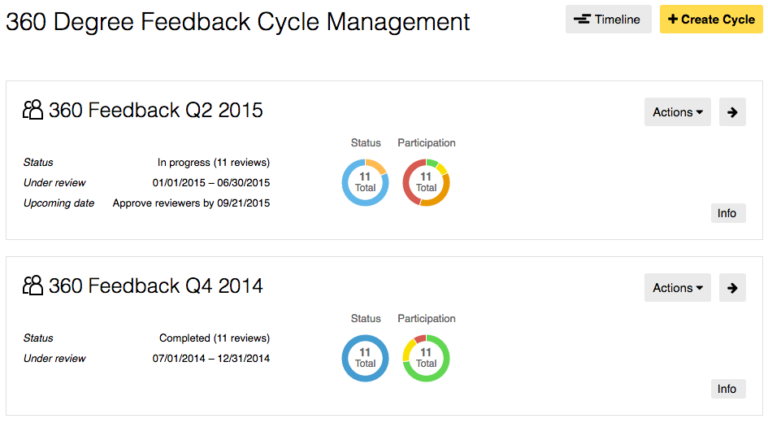
Employee onboarding using 1:1 Meeting templates and Objectives
Many companies approach an employee’s on-boarding by having new joiners participate in some form of 30-60-90 day review. This article outlines the best way to leverage the 1:1 Meeting notes and Objectives features to best facilitate these and avoid having to set up numerous Performance Review cycles with only one participant.
Table of Contents
Using 1:1 meeting templates
Managers find it helpful to have a set of expectations, or a workflow, to run through when on-boarding a new team member. Setting up a 1:1 Meeting template will help to support them doing this and doing it well. It will also save them a lot of time and ensures that your on-boarding process has consistency across teams.
- Consider including talking points to introduce them to their teammates, the projects that are currently being worked on, office protocols and schedules, best restrooms, anything that can help them get acclimated and feel as though they belong as quickly as possible.
- We have a inspiration for questions here: 24 questions to ask in your next 1:1 meeting
Below is an example template in action:

Creating Objectives
You might also consider adding that they two create an on-boarding objective that they both track progress of over their trial/introductory period. Include this step as a talking point in your on-boarding 1:1 Meeting note template to ensure that it sets a clear expectation.
-
Tracking progress of a goal you set together along the way is much more proactive as an approach to 90 day reviews because the objective clearly outlines what it will take to be successful in that on-boarding period.
Below is a first 90 day objective action plan example:

Benefits to Performance Management
The benefit to having an objective to track progress of is that there is now a container to keep a tally of ongoing feedback and accomplishments that can be reviewed at the end of the introductory period.
Reflecting within the first 90 days
At the end of the introductory period, you might have another 1:1 template for the two of them to complete that summarizes the experience and sets the foundation of the feedback relationship that they’ll have moving forward.
Talking points such as: what went well, areas for continued growth, aspirations for their employment there, etc.
To gain even further insights into the new employees on-boarding, have them solicit feedback from those they worked with by using our Request Feedback feature. To ensure this is consistent, why not create a template for them to utilize as part of the process. This can then be another talking point added to the 90 day reflection 1:1 Meeting template.
This on-boarding objective and the relevant on-boarding 1:1 Meeting notes will add a layer of extra feedback that will support the manager and employee during their first formal Performance Review and/or 360 later on in the year.
Discover more resources

How to grow and scale culture the Reddit way
Small Improvements invited Reddit’s People & Culture team to Berlin for an evening of informative conversation packed with actionable tips for HR managers.

Introducing a performance review system – the gentle way
If you want to redesign your performance review process but feel that selling the idea to your team might be difficult, you’ve come to the right place! Instigating change is tricky, and introducing a new performance management system can backfire if not done properly. Read on for some suggestions on how to get started and…

Getting the most out of 360 degree feedback
Guest blog post by Beth Steinberg. Beth has over 18 years of experience in organization development, talent strategy, and leadership development. Her focus has been to help leaders and companies with complex organizational and growth issues. Beth focuses on driving useful employee programs, leadership coaching, executive development and organizational development. Few concepts in psychology are…

Manage your cycles in style: Faster access, slick timeline view
One of the most important HR tasks in Small Improvements is creating and managing cycles – whether for Performance Reviews, 360 degree Feedback, or Objectives. Today we’re relaunching our cycle management screens to feature an improved look and feel, and to provide advanced interaction possibilities. We started with the name – calling the feature Cycle…

7 best practices for giving peer feedback
Creating an active peer feedback culture might be tough. With these best practices, you’ll be able to navigate any challenge with ease.

Performance reviews and compensation: Taking money off the table
Trying to make pay decisions based on performance reviews can get in the way of employee growth. Here’s why, and what you can do instead.